St John's Lutheran Church
Ebenezer Road, Ebenezer
B 1875 D.H. Lemke. 1 manual, 4 speaking stops, no pedals, foot blown. Man: 8.8.4.2.
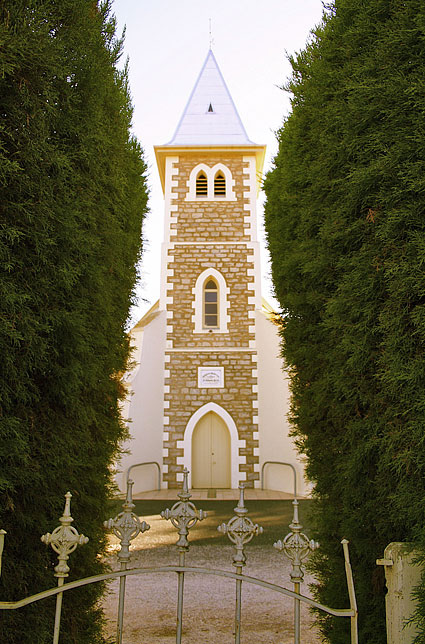
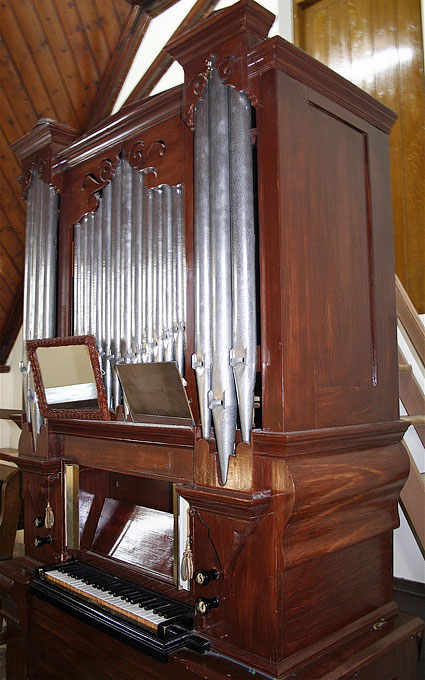
Photos: Trevor Bunning (March 2009)
The organ in St John's Lutheran Church, Ebenezer, was built by D.H. Lemke in 1875. This date, together with Lemke's signature is written on one of the wooden pipes inside the organ. This organ can still be foot-pumped. The amount of air in the bellows is indicated by two tassels situated on either side of the keyboard. While playing the organ the performer needs to give constant attention to the position of these tassels - it is very easy for the wind to "run out" quite suddenly and unexpectedly.
The superb tonal qualities of this organ remain undiminished and undisturbed by the passage of time. A slight unsteadiness of wind-suply adds a "breath of of life" to this organ.
| Manual Stopped Stopped Principal Octave |
8 8 4 2 |
wood wood metal metal |
49 pipes 30 pipes 49 pipes 49 pipes |
Compass: 4 octaves
Foot blow with treadles, blower added 1992
Built fo DH Lemke and deicated on 2 May, 1875 by Rev. Niquet.
From
the 2009 OHTA Conference Book,
David Shield writes:
The
organ at Ebenezer preceded the current church building. The first German settlers to the
District had arrived in 1852 and organised into a congregation with Meyer of
Bethany as their Pastor. In 1854,
Pastor C.S.D. Schneider of the Moravian Brethren took charge and the seemingly
inevitable split in the Congregation occurred resulting in the church at
Neukirch being formed. The Bethany
schoolhouse was constructed in 1858 and still stands. For about five years, Johann Dallwitz, the first teacher,
undertook schooling in Wendish, the only one known in Australia.1 Andreas Dallwitz who, from his
appointment in 1863 to 1809, was also the church organist, followed him. The school was then conducted in
German. A new church with thatched
roof was dedicated on 13 February 1859.
In turn, it was demolished, the new building being dedicated on 9 April
1905. The bell of 1890 was
remounted from its belfry to the tower and the organ, acquired in 1875, was
also relocated. It is now to be
found in the west end gallery.
The
church bell arrived in 1890. A
gift of Johann Mickan it was cast in bronze at the foundry of F. Otto,
Hemelingen in 1889. The diameter
at the mouth is 818 mm and it weighs 321 kg. Other bells from this foundry are to be found at Bethany
(1881) and St John’s, Tanunda (1886).
Originally the bell was mounted in a separate belfry. It rings out the tone of A#.2
When
John Stiller documented the organ in 1980, he noted two historical
inscriptions, both identifying the dedication date. Written on one of the wooden pipes at the back of the organ
was “1875 / dedication of the / organ on the 2nd May / D H Lemke”. The other inscription written on one of
the casework panels read “Dedication of this organ by Pastor / Niquet on 2nd
May 1875.”
Like
all the instruments by Lemke, the organ at Ebenezer has four ranks of pipes
denoted only by their pitch.
Stiller notes that only the two wooden 8ft ranks of the organs were
constructed by Lemke. This leads
to conjecture as to where, or from whom, Lemke obtained his metal pipes.
The
extant Lemke organs were built in the period 1870 to 1876. The display pipes come from the 4 and 2
foot ranks and, with the exception of Gruenberg, each are arranged in the same
pattern of three flats of 3:13:3.
The Gruenberg flats have two less pipes in the centre, 3:11:3. The earliest organ, for Gruenberg, uses
plain metal pipes; Ebenezer has spotted metal; Immanuel Point Pass has both
plain and spotted metal and Stiller refers to the ranks containing “odd
second-hand pipes”,3 and the Light Pass (Frankston) organ spotted
metal.
The
“best” pipe metal was used in at least one of the organs. An article in 1874 indicates the organ
was “devised according to the builder’s own ideas” and “the individual
registers consist of 8 foot Lieblich Gedackt, 8 foot streng gedackt, 4 foot principal
and 2 foot octave, the last two made of the best pipe metal.” This related to the third organ built
in Gruenberg by Lemke, presumably that for Point Pass.4
Much
has been made of the fact that inscriptions have been found on both the
Gruenberg and Light Pass organs that work was done on them by Robert Mackenzie.5 This leads Lutz to suggest he provided
the pipes perhaps from his previous employers William Hill & Son. Although Robert Mackenzie visited South
Australia in 1873 to erect the Hill & Son organ in the Kent Town Wesleyan
Church6 and returned in 1877 to erect the organ for the Adelaide
Town Hall, he did not reside in the Colony until the end of the following year
at the earliest.7 Lutz
goes further and suggests that as J.J. Broad employed Mackenzie it might have
been Broad who imported the pipes for Lemke.8 However, in March 1881, there was a
suspicious fire in Mackenzie’s workshop in North Adelaide and in 1886 he spent
a year in jail for fraud. In the
interim he appears to have been employed by Broad as there is indirect
reference to his workmanship on an instrument on show in Broad’s shopfront in
1885.9
If
Lemke did not make his own metal pipes, it becomes clear that the dates of
construction for each instrument may determine their supplier. In the inscription on the Lights Pass
instrument Mackenzie refers to himself as “organ builder of Adelaide”. For this to be correct it must relate
to a date after 1879. Note that
this organ was placed in the church in 1876 not built c.1885, when Lemke was
farming at Sandleton.10
At
this point of time, Johann Wilhelm Wolff was the prominent builder of organs in
Adelaide. There was a tariff on
imported pipe organs in both South Australia and Victoria though not on the
pipes alone or organ components.
Both Wolff and George Fincham of Melbourne made their own pipes and were
known to have been protectionists.11
However,
to 1874, Wolff’s instruments only contained wooden pipes. From 1875 he included metal pipes and
it is known that for at least one organ of his construction he obtained them
from Speechly & Co. in England.12 It is reasonable to suggest that Lemke acquired his metal
pipes through Wolff rather than Mackenzie although this cannot be verified. Apart from a house organ built c.1892,
the last instrument made by Wolff was in 1880 for the Wesleyan Church in
Norwood, now redundant and under threat, located in the Church of Christ,
Adelaide. Fincham made his own
metal pipes.
In
1880, it would seem that Lemke removed himself from any contact with any of his
organs. Whereas he had spent some
time repairing the Krüger instrument at Bethany in 1879, the following year he
had resigned from teaching and returned to farming. He had leased a block of land at Sandleton since 1876 and on
15 September 1880 a congregation was formed with a church built on his
property, the building being dedicated on 16 October 1881. It had no organ, Daniel accompanying
the hymns on his violin. Lemke
died in 1897.
That
Mackenzie worked on the Lemke organs is not in question. To say he provided the metal pipework
seems tenuous by virtue of the dates of their construction. Exactly what work he undertook is
unclear and a source of further detailed research. It is more logical to suggest the pipes were obtained
through Wolff but this also is contestable.
According
to Stiller, no significant work had been done to the organ to 1980. The casework is of pine, stained and
varnished. Pitch was given as a1=
446Hz at 270C on a wind pressure of 32mm (1 ¼ inches). The short compass keyboard has 49 notes
(C-c3). It is blown by
foot treadles L.R. Waters undertook some work in the 1960s, but all records of
this firm were destroyed on his death, so details of what was undertaken are
unknown.
Earlier
this year the key fronts were replaced using Huon pine timber. The celluloid on the keys was also
replaced.13
Daniel Lemke 1875
1 manual, 4 speaking stops, no
pedals, mechanical action
MANUAL
8 [Gedact
larger scale]
8 [Gedact smaller
scale]
4 [Principal]
2 [Octave]
Compass 49
notes C-c
Pitch
designations only on stop labels
Foot and
electric blown
1 Munchenberg, et al, The Barossa A vision realised, p109
(St John’s Lutheran Church, Ebenezer Lutheran Archives pamphlet)
2 Ibid., Bagot, H., ‘Bells of the Barossa’, Journal
of Friends of Lutheran Archives,
no 10 (October 2000), pp. 9-16
3 Stiller, J., Documentation
Immanuel Lutheran Church Point Pass,
21 December 1978 and 21 December 1979.
4 The photocopied article, possibly from
the Sued-Australische Zeitung, was
included in a personal letter from L. Grope to J. Stiller 11 January 1985. Note error in Lutz, M. The Work
Praises the Man, 1996, p.18. The article refers to it being Lemke’s
third instrument built in Gruenberg, not that Gruenberg was his third
instrument.
5 “The organ was voiced, tuned and regulated by Robert Mackenzie,
organbuilder of Adelaide.” Noted by Marc Nobel on the 1876 Lemke instrument at
Frankston Victoria, formerly at Light Pass South Australia, Past Evidence
Future Keys OHTA Conference Book
2008, p.83. The wording at
Gruenberg does not appear to have been determined: Lutz, M., ‘Lehrer Lemke’, OHTA
News vol 19, no 4 (October 1995),
pp.16-19 and repeated in Lutz, M., The Work praises the Man 1996, pp. 18,20-23. Mackenzie was open to exaggerate the nature of his work so
exactly what was undertaken is unclear.
6 Register, 25 October 1873, p.6.3
7 His Melbourne business
was sold to Fincham in 1878.
Matthews, E.N. Colonial Organs and Organbuilders, Carlton: Melbourne University Press, 1969, p.28.
8 Lutz, op.cit. 1996 p.21
9 Register, 26
March 1881, p. 5.3; ibid., 28 March 1881, p.4.7; Adelaide Observer, 10
April 1886, p.39.1; Register,
7 January 1885, p.5.1. See also sections in conference book
under Marananga and Kapunda
10 See section on
Immanuel Light Pass; also Past Evidence Future Keys, op.cit., pp.83-85
11 Register, 21 March 1870, p.5.1; see also Matthews, op.cit.,
p.17
12 Advertiser, 21 August 1875, p.4.6: St John’s Church of England, Halifax Street, Adelaide
13 Noted S. Kaesler 2009
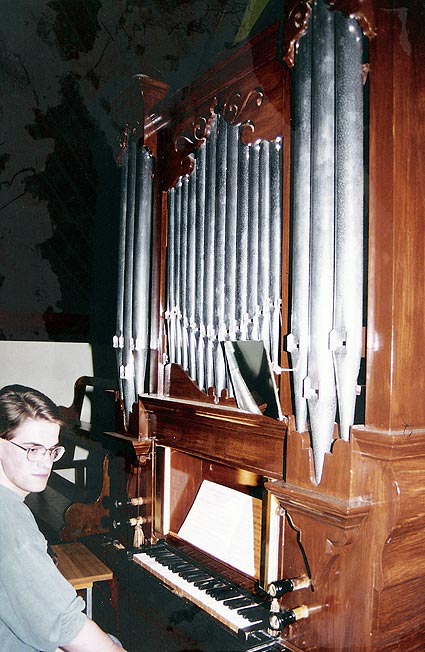
Scott Angove at console
Photos: Trevor Bunning (Jan. 1994)
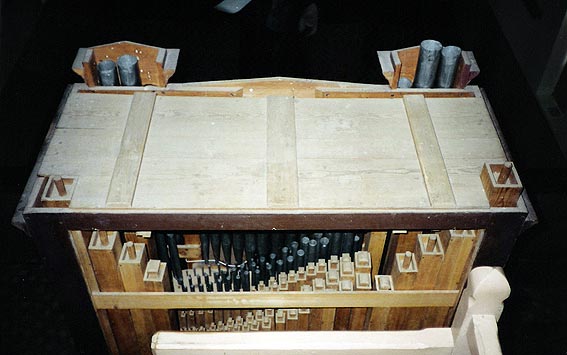
Case from tower
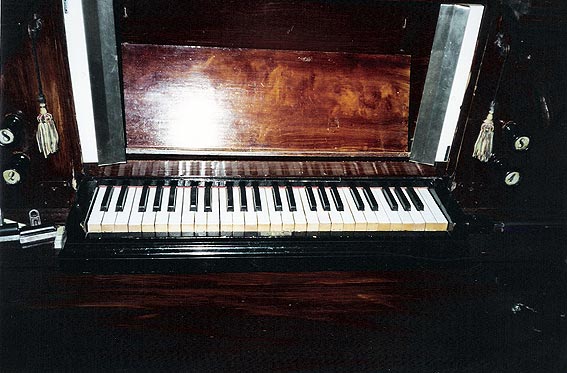
Console
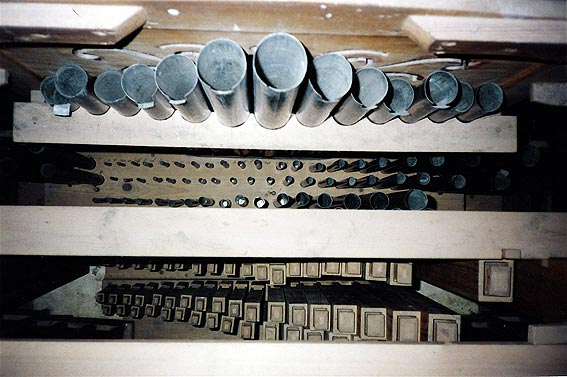
Case top removed
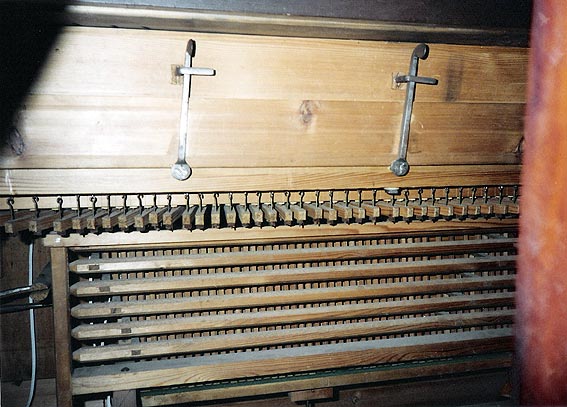
Roller board & fan frame levers
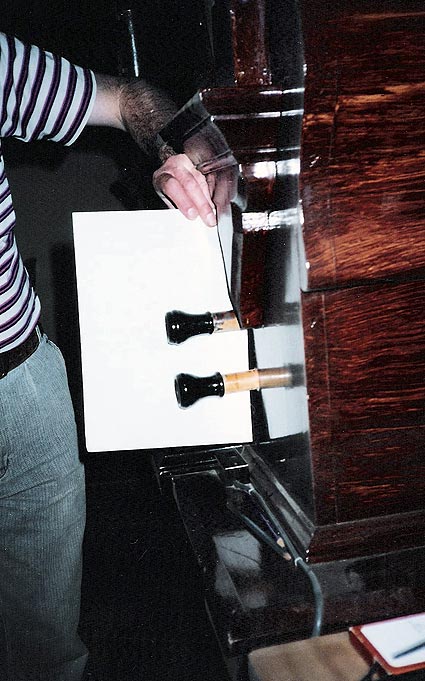
Stop jamb detail
Five photos above: Roger Jones
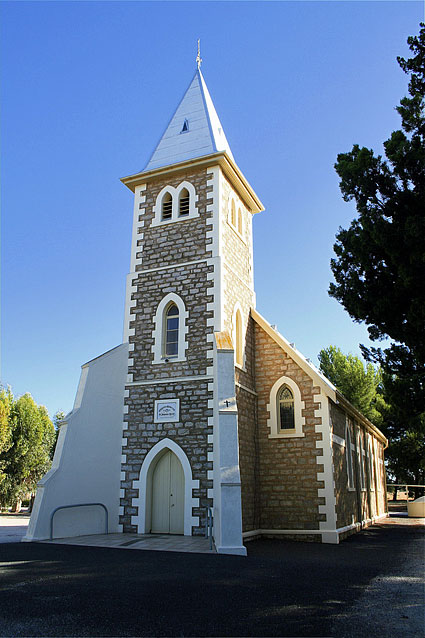
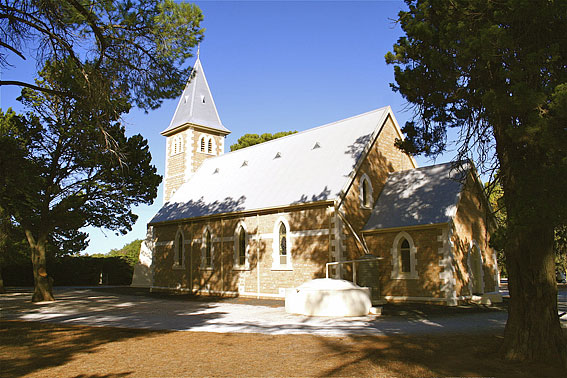
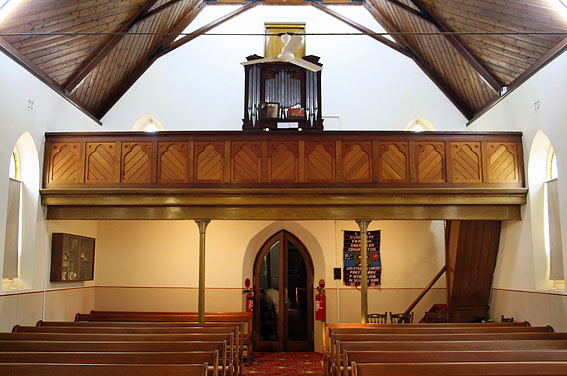
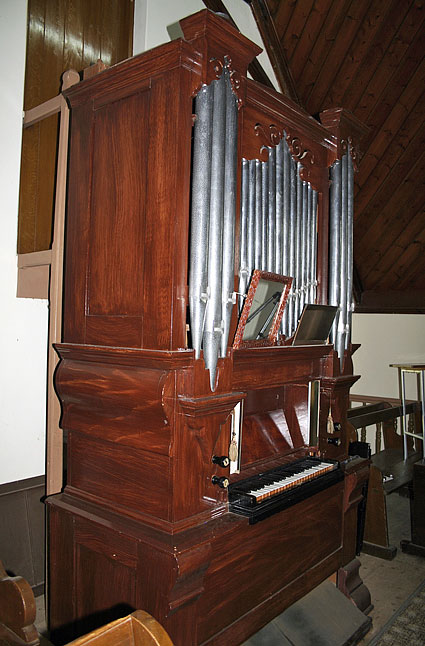
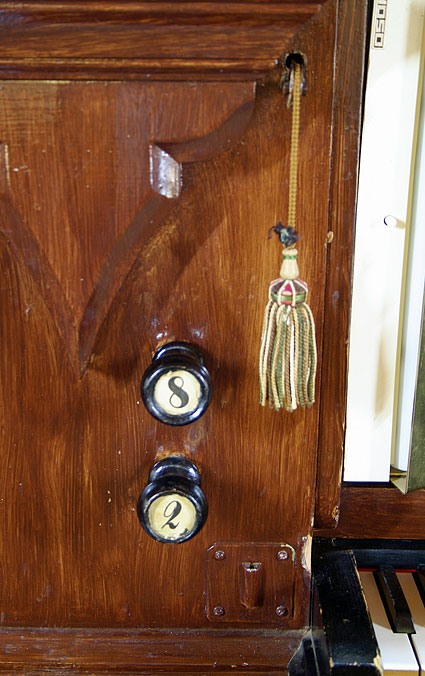
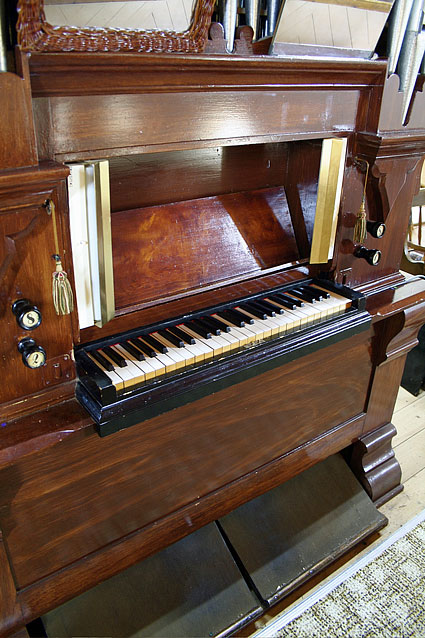
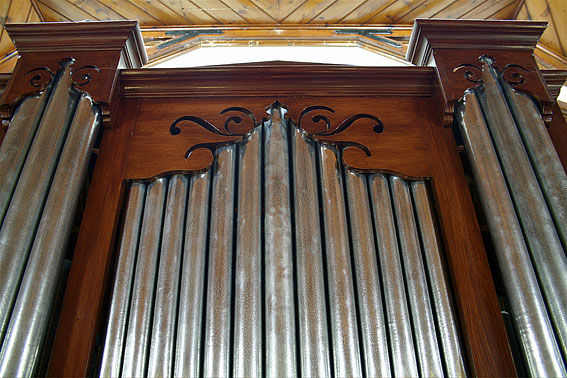
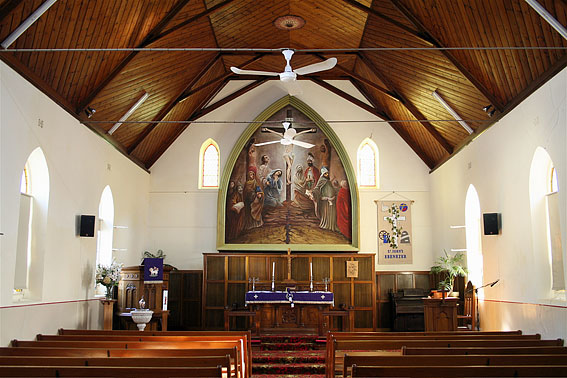
Photos: Trevor Bunning (March 2009)